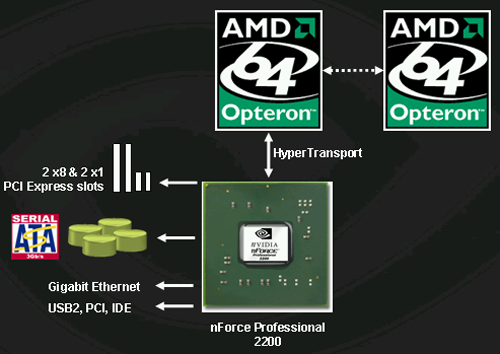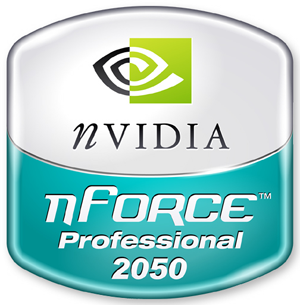NVIDIA nForce Professional Brings Huge I/O to Opteron
by Derek Wilson on January 24, 2005 9:00 AM EST- Posted in
- CPUs
NVIDIA nForce Pro 2200 MCP and 2050 MCP
There will be two different MCPs in the nForce Professional lineup: the nForce Pro 2200 and the nForce Pro 2050. The 2200 is a full-featured MCP, and while the 2050 doesn't have all the functionalty of the 2200, they are based on the same silicon. The feature set of the NVIDIA nForce Pro 2200 MCP is just about the same as the nForce 4 SLI and is as follows:
- 1 1GHz 16x16 HyperTransport Link
- 20 PCI Express lanes configurable over 4 physical connections
- Gb ethernet w/ TCP/IP offload Engine (TOE)
- 4 SATA 3Gb/s
- 2 ATA-133 channels
- RAID and NCQ support (RAID can span SATA and PATA)
- 10 USB 2.0
- PCI 2.3
The 20 PCI Express lanes can be spread out over 4 controllers at the motherboard vendor's discretion via NVIDIA's internal crossbar connection. For instance, a board based on the 2200 could employ 1 x16 slot and 1 x4 slot, or 1 x16 and 3 x1 slots. It cannot host more than 4 physical connections or 20 total lanes. Technically, NVIDIA could support configurations like x6 which don't match PCI Express spec. This may prove interesting if vendors decide to bend the rules on anything, but likely server and workstation products will stick to the guidelines.
Maintaining SATA and PATA support is a good thing, especially with 4 SATA 3Gb/s channels, 2 PATA channels (for 4 devices), and support for RAID on both. Even better is the fact that NVIDIA's RAID solution can be applied across a mixed SATA/PATA environment. Our initial investigation of NCQ wasn't all that impressive, but hardware is always improving, and applications in the professional space are a good fit to NCQ features.

This is the layout of a typical system with the nForce 2200 MCP.
The nForce Pro 2050 MCP, the cut down version of the 2200 that will be used as an I/O add-on, supports these features:

- 1 1GHz 16x16 HyperTransport Link
- 20 PCI Express lanes configurable over 4 physical connections
- Gb ethernet w/ TCP/IP offload Engine (TOE)
- 4 SATA 3Gb/s
Again, the PCI Express controllers and lanes are configurable. Dropping this down to add those plus another GbE and 4 more SATA connections is an obvious advantage, but there is more.
As far as we can tell from this list, the only new feature introduced from nForce 4 is the TCP/IP offload Engine in the GbE. Current nForce 4 SLI chipsets are capable of all other functionality discussed in the NFPro 2200 MCP, although there may be some server level error reporting built into the core logic of the Professional series that we are not aware of. After all, those extra two million transistors had to go somewhere.
But that is definitely not all there is to the story. In fact, the best part is yet to come.










55 Comments
View All Comments
smn198 - Friday, January 28, 2005 - link
It does do RAID-5!http://www.nvidia.com/object/IO_18137.html
w00t!
smn198 - Friday, January 28, 2005 - link
#18It can do RAID-5 according to http://www.legitreviews.com/article.php?aid=152
Near bottom of page:
"Update: NVIDIA contacted us to let us know that RAID 5 is also supported on the 2200 and 2050. They also didn't hesitate to point out that when the 2200 is matched with three 2050's, the RAID array can be spanned across 16 drives!"
However, nidia's site does not mention it! http://www.nvidia.com/object/feature_raid.html
I wonder. would be nice!
DerekWilson - Friday, January 28, 2005 - link
#50,each lane in PCIe consists of a serial up link and down link. this means that x16 actually has 4Gb/s up and down at the same time (thus the 8Gb/s number everyone always quotes). Saying 8Gb/s bandwidth without saying 4 up and 4 down is a lil misleading because that bandwidth can't move in one direction when needed.
#53,
4x SATA 3Gb/s -> 12Gb/s -> 1.5GB/s + 2GbE -> 0.25GB/s + USB 2.0 ~-> .5GB/s = 2.25 GB/s ... so this is really manageable bandwidht. Especially as its unlikely for all this to be moving while all 5 gig up and down of the 20 PCIe lanes are moving at the same time.
It's more likely that we'll see video cards setting aside 30% of the PCI Express b/w to nearly idle (as, again, upload is often not used). Unless using the 2 x16 SLI ... We're still not quite sure how much bandwidth this will use over the top and through the PCIe bus. But one card is definitely going to send data back up stream.
Each MCP has a 16x16 HT link @ 1GHz to the system... Bandwidth is 8GB/s (4 up and 4 down) ...
guyr - Thursday, January 27, 2005 - link
Can anyone explain how these MCPs work regarding throughput? What kind of clock rate do they have? 4 SATA II drives alone is 12 Gbps. Add 2 GigE and that is 14. Throw in 8 USB 2.0 and that almost an additional 4 Gbps. So if you add everything up, it looks to be over 20 Gbps! Oops, sorry, forgot about 20 lanes of PCIe. Anyway, has anyone identified a realistic throughput that can be expected? These specs are wonderful, but if the chip can only pass 100 MB/s, it doesn't mean anything.jeromechiu - Thursday, January 27, 2005 - link
#12, if you have a gigabit switch that supports port trunking, then you could use BOTH of the gigabit ports for faster intranet file-transfer. Hell! Perhaps you could add another two 4-port gigabit adaptors and give your PC a sort-of-10Gbps connection to the switch! ;)philpoe - Wednesday, January 26, 2005 - link
Being a newbie to PCI-E, if I read a PCI-Express FAQ correctly, aren't the x16 slots in use for graphics cards today 1 way only? Too bad the lanes can't be combined, or you could get to a 1-way x32 slot (apparently in the PCI-E spec). In any case, 4 x8 full duplex cards would be just the ticket for Infiniband (making all that Gbe worthless?) and 4 x2 slots for good measure :). Just think of 16x SATA-300 drives attached and RAID. Talk about a throughput monster.Imagine Sun, with the corporate-credible Solaris OS selling such a machine.
DerekWilson - Tuesday, January 25, 2005 - link
#32 henry, and anyone who saw my wrong math :-)You were right in your setup even though you only mentioned hooking up 4 x1 lanes -- 2 more could have been connected. Oops. I've corrected the article to reflect a configuration that actually can't be done (for real this time, I promise). Check my math again to be sure:
1 x16, 2 x4, 6 x1
that's 9 slots with only 8 physical connections. still with 10 lanes left over. In the extreme I could have said you can't do 9 x1 connectios on one board, but I wanted to maintain some semblance of reality.
Again, it looks like the nForce Pro is able to throw out a good deal of firepower ....
ceefka - Tuesday, January 25, 2005 - link
Plus I can't wait to see a rig like this doing benchies :-)ceefka - Tuesday, January 25, 2005 - link
In one word: amazing!Some of this logic eludes me, however.
There's no board that can fully exploit the theoretical connectivity of a 4-way opteron config with these chipsets?
SunLord - Tuesday, January 25, 2005 - link
I'd pay upto $450 for a dual cpu/chipset board as long as it gave me 2x16 1x4 and 1-3x1 connectors... as I see no use for pci-x when pci-e cards are coming out... Would make for one hell of a workstation to replace my aging athlon mp using tyan thunder k7 pro board. Even if the onbaord raid doesn't do raid 5 I can use the 4x slot for a sata2 raid card with little to no impact! Though 2 gigabit ports is kinda overkill. mmm 8x74GB(136GB) raptor raid 0/1 and 12x500GB(6TB) Raid 5 3Ware/AMCC controller.I can dream can't I? No clue what I would do with that much diskspace though... and still have enough room for 4 dvd-+rw dual layer burners hehe